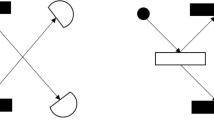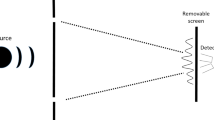Abstract
Delayed-choice experiments in quantum mechanics are often taken to undermine a realistic interpretation of the quantum state. More specifically, Healey has recently argued that the phenomenon of delayed-choice entanglement swapping is incompatible with the view that entanglement is a physical relation between quantum systems. This paper argues against these claims. It first reviews two paradigmatic delayed-choice experiments and analyzes their metaphysical implications. It then applies the results of this analysis to the case of entanglement swapping, showing that such experiments pose no threat to realism about entanglement.

Similar content being viewed by others
Notes
For an extensive review of this development and the current state of play, see [12].
Healey advances this argument in the context of his pragmatist approach to quantum theory, which I will not discuss here. Neither will I discuss the positions of those who take quantum information theory to support an epistemic or informational (as opposed to metaphysical) view of the quantum state. See [26] for a critique of these approaches.
An anonymous referee has reminded me of the fact that there is also a continuous spectrum of intermediate cases, parametrized by the degree to which WW information is obtained (see [7, Chap. 1] for a classic discussion). This might be seen as an additional problem for a naive “either-wave-or-particle” view, but I am here only interested in the specific problems arising from the delayed-choice setting. For this purpose, it suffices to look at the two extreme cases of a pure DS and a pure WW experiment.
For the following, I adopt the notation of [5].
I should mention that Mohrhoff has earlier defended a “reality-of-states point of view” himself [18]. Therefore, I cannot claim originality for much of what I will have to say in the rest of this section. In response to criticism by Englert et al. [5], Mohrhoff later abandoned this view in favor of a “reality-of-phenomena point of view”, which may be seen as a kind of compromise between the minimalistic interpretation advocated by Englert et al. and realism about the quantum state. The details of this debate do not matter here, because I am not attempting to evaluate the final positions of either of the two parties, but am only concerned with the claim that quantum state realism is not viable, a claim which seems to be common ground between Englert et al. and Mohrhoff’s more recent paper.
As is well known, there is no satisfying characterization of “measurement” within standard quantum mechanics [2]. The reality-of-states view presented here is compatible with different solutions to this problem, e.g., the GRW theory or an Everett-type approach. In the latter case, state reduction is to be understood as a branching of worlds due to environment-induced decoherence. Some additional remarks on how this plays out in the experiments discussed here will be given in footnotes 9 and 13.
This becomes problematic in a relativistic context, where the temporal ordering of spacelike separated events depends on the reference frame. The question of how to reconcile quantum non-locality with relativity is beyond the scope of this paper (see [16] for an insightful discussion). But since an anonymous referee has pressed me on this point, I offer the following justification for assuming a well-defined temporal ordering between any two events: Some of the most widely discussed realistic versions of quantum theory (e.g., Bohmian mechanics and the matter-density version of GRW) involve a commitment to a preferred foliation of spacetime. If these proposals are reasonable, then so is the assumption that there is a definite (although undetectable) temporal ordering between any two events.
For details about the coefficients \(\alpha\) and \(\beta\), see [5, Eq. (8)]. Of course, we could equally well express the photon state in the \(|+\rangle \), \(|-\rangle \) basis.
Although I have derived this result within a view that takes state reductions as real events, it is interesting to note that the result is not peculiar to such a view. Hiley and Callaghan [11] analyze the situation from a Bohmian perspective, which does not regard state reductions as real, but instead assigns a definite trajectory to each atom. Their conclusion is analogous to mine, namely that the retrospective sorting into subensembles does not correspond to differences in the trajectories of the atoms.
From an Everettian perspective, there is a sense in which the subensembles never have any metaphysical significance: Strictly speaking, according to Everettian quantum mechanics, superpositions never disappear, hence if the atom started out as part of an entangled system, it never enters into one of the \(\psi_{i}\) states. But in that sense, no experience ever has metaphysical significance, because our experiences keep telling us that the world around us is in some unique, non-superposed state, while it really is not. Everettians usually prefer a less drastic formulation, according to which our experience is not so much illusory as merely incomplete: The macroscopic world we experience then counts as perfectly real, but it is only one branch among infinitely many others which we do not experience. With such a branch-relative notion of reality in place, the metaphysical significance of the measurement subensembles can be assessed in exactly the same way as in a theory with state reduction. If the photon is measured first, branching occurs (due to decoherence), and within each branch, the atom really (in the branch-relative sense) enters into one of the \(\psi_{i}\) states. By contrast, if the measurement of the photon is delayed, the atom never is in such a state (not even in the branch-relative sense), because no branching occurs until the atom hits the screen.
The proposal has recently been experimentally realized [14].
In an Everettian context, “really” here again has to be understood in a branch-relative sense. Analogously to the situation described in footnote 9, the important contrast is that in the delayed-choice case, the \((A,D)\) pair never (not even in a branch-relative sense) is in a pure state.
At the time of revising this article, Megidish et al. [17] reported a rather spectacular variant of a delayed-choice entanglement-swapping experiment, in which the photons \(A\) and \(D\) not only never interact, but never even coexist. My analysis straightforwardly applies to this case as well: Since the complete system is not in state \(|\varPsi\rangle \) at the time the \((B,C)\) measurement occurs (in fact, there is no four-particle system at any time in this experiment), no actual entanglement swapping takes place.
References
Allori, V., Goldstein, S., Tumulka, R., Zanghì, N.: On the common structure of Bohmian mechanics and the Ghirardi-Rimini-Weber theory. Br. J. Philos. Sci. 59, 353–389 (2008)
Bell, J.S.: Against ‘measurement’. In: Miller, A.I. (ed.) Sixty-Two Years of Uncertainty: Historical, Philosophical, and Physical Inquiries into the Foundations of Quantum Mechanics, 2nd edn., pp. 213–231. Plenum Press, New York (1990). Reprinted in J.S. Bell: Speakable and Unspeakable in Quantum Mechanics. Cambridge University Press, Cambridge (2004)
Clifton, R.: The subtleties of entanglement and its role in quantum information theory. Philos. Sci. 69, S150–S167 (2002)
Dürr, D., Goldstein, S., Zanghì, N.: Bohmian mechanics and the meaning of the wave function. In: Cohen, R., Horne, M., Stachel, J. (eds.) Experimental Metaphysics: Quantum Mechanical Studies for Abner Shimony. Boston Studies in the Philosophy of Science, vol. 193, pp. 25–38. Kluwer Academic, Dordrecht (1997)
Englert, B.G., Scully, M.O., Walther, H.: Quantum erasure in double-slit interferometers with which-way detectors. Am. J. Phys. 67, 325–329 (1999)
Esfeld, M.: Quantum entanglement and a metaphysics of relations. Stud. Hist. Philos. Mod. Phys. 35, 601–617 (2004)
Feynman, R.P., Leighton, R.B., Sands, M.: The Feynman Lectures on Physics, vol. 3. Addison-Wesley, Reading (1965)
French, S.: Individuality, supervenience and Bell’s theorem. Philos. Stud. 55, 1–22 (1989)
Healey, R.: Quantum theory: a pragmatist approach. Br. J. Philos. Sci. 63, 729–771 (2012)
Hiley, B.J., Callaghan, R.E.: Delayed-choice experiments and the Bohm approach. Phys. Scr. 74, 336–348 (2006)
Hiley, B.J., Callaghan, R.E.: What is erased in the quantum erasure? Found. Phys. 36, 1869–1883 (2006)
Horodecki, R., Horodecki, P., Horodecki, M., Horodecki, K.: Quantum entanglement. Rev. Mod. Phys. 81, 865–942 (2009)
Jennewein, T., Weihs, G., Pan, J.W., Zeilinger, A.: Experimental nonlocality proof of quantum teleportation and entanglement swapping. Phys. Rev. Lett. 88, 017,903 (2002)
Ma, X.s., Zotter, S., Kofler, J., Ursin, R., Jennewein, T., Brukner, Č., Zeilinger, A.: Experimental delayed-choice entanglement swapping. Nat. Phys. 8, 480–485 (2012)
Maudlin, T.: Part and whole in quantum mechanics. In: Castellani, E. (ed.) Interpreting Bodies: Classical and Quantum Objects in Modern Physics, pp. 46–60. Princeton University Press, Princeton (1998)
Maudlin, T.: Quantum Non-Locality and Relativity, 3rd edn. Wiley-Blackwell, Chichester (2011)
Megidish, E., Halevy, A., Shacham, T., Dvir, T., Dovrat, L., Eisenberg, H.S.: Entanglement swapping between photons that have never coexisted. Phys. Rev. Lett. 110, 210,403 (2013)
Mohrhoff, U.: Restoration of interference and the fallacy of delayed choice: concerning an experiment proposed by Englert, Scully, and Walter. Am. J. Phys. 64, 1468–1475 (1996)
Mohrhoff, U.: Objectivity, retrocausation, and the experiment of Englert, Scully, and Walther. Am. J. Phys. 67, 330–335 (1999)
Pan, J.W., Bouwmeester, D., Weinfurter, H., Zeilinger, A.: Experimental entanglement swapping: entangling photons that never interacted. Phys. Rev. Lett. 80, 3891–3894 (1998)
Peres, A.: Delayed choice for entanglement swapping. J. Mod. Opt. 47, 139–143 (2000)
Scully, M.O., Drühl, K.: Quantum eraser: a proposed photon correlation experiment concerning observation and “delayed choice” in quantum mechanics. Phys. Rev. A 25, 2208–2213 (1982)
Scully, M.O., Englert, B.G., Walther, H.: Quantum optical tests of complementarity. Nature 351, 111–116 (1991)
Seevinck, M.: The quantum world is not built up from correlations. Found. Phys. 36, 1573–1586 (2006)
Teller, P.: Relational holism and quantum mechanics. Br. J. Philos. Sci. 37, 71–81 (1986)
Timpson, C.G.: Information, immaterialism, instrumentalism: old and new in quantum information. In: Bokulich, A., Jaeger, G. (eds.) Philosophy of Quantum Information and Entanglement, pp. 208–227. Cambridge University Press, Cambridge (2010)
Timpson, C.G., Brown, H.R.: Building with quantum correlations. Quantum Inf. Process. 9, 307–320 (2010)
Wheeler, J.A.: The ‘past’ and the ‘delayed-choice’ double-slit experiment. In: Marlow, A.R. (ed.) Mathematical Foundations of Quantum Theory, pp. 9–48. Academic Press, New York (1978)
Yurke, B., Stoler, D.: Einstein-Podolsky-Rosen effects from independent particle sources. Phys. Rev. Lett. 68, 1251–1254 (1992)
Żukowski, M., Zeilinger, A., Horne, M.A., Ekert, A.K.: “Event-ready-detectors” Bell experiment via entanglement swapping. Phys. Rev. Lett. 71, 4287–4290 (1993)
Acknowledgements
I am grateful to the audiences at the BSPS annual conference (Stirling, July 2012) and the PSA biennial conference (San Diego, November 2012) for inspiring discussions. I also wish to thank Michael Esfeld, Vincent Lam, Jakob Sprickerhof, Stevie Turkington, Charles Sebens and two anonymous referees for many helpful comments.
Author information
Authors and Affiliations
Corresponding author
Rights and permissions
About this article
Cite this article
Egg, M. Delayed-Choice Experiments and the Metaphysics of Entanglement. Found Phys 43, 1124–1135 (2013). https://doi.org/10.1007/s10701-013-9734-4
Received:
Accepted:
Published:
Issue Date:
DOI: https://doi.org/10.1007/s10701-013-9734-4




